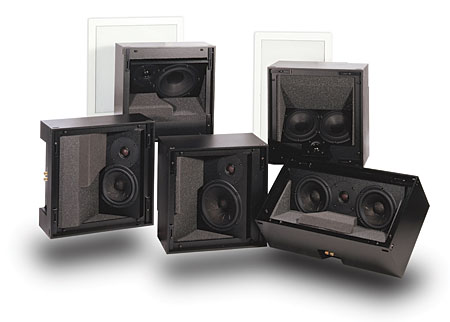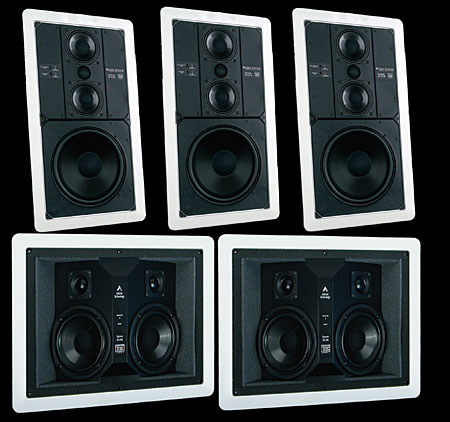Invisible Speakers
In the early 1980s, as an audio salesperson for a Chicago-area A/V retail/custom-install store, I fielded a phone call from Godehard Guenther, the founder and president of a/d/s/. We were one of the largest dealers for their fine line of automotive speakers, and he wanted photos of some of our high-end auto-sound installations featuring a/d/s/. "We don't even have a car-stereo department," I responded, freezing him mute. "We're installing your speakers into the walls of homes." This brilliant former NASA engineer and one-time employee of Wernher von Braun was dumbfounded. Car speakers cut into the walls of houses—what a concept.

In those days of platform heels, Kool & the Gang, and cheap Sunoco 260 gasoline, there wasn't exactly a plethora of choices for high-end custom-install speakers—speakers that actually installed into walls, cabinets, or ceilings. But our customers wanted great sound, and they wouldn't tolerate big, black monoliths cluttering their homes to get it. Today, there's a stronger emphasis on interior design, and that tolerance level is even lower.
These Days
Twenty-five years later, custom-install speakers have developed into a big business, and now the choices are numerous. There are speakers made to be mounted on the wall, in the wall, in the ceiling, in the corner, in a cabinet, under a plasma television, in a sauna, outdoors, and even in the floor. There are custom-install speakers for stereo and distributed audio, in addition to such speakers and subwoofers for home theaters. There's also a vast range of quality and price, from less than $50 each to many thousands of dollars each. Making an intelligent decision on what is right for you can be daunting.
If there is one pearl of wisdom to be distilled from this, it is to pick the appropriate speaker for the specific application. And I would strongly advise choosing a competent custom installer who can help you make the important decisions. A good installation company will have expert design capability and good installers, and they will carry reputable products that are serviceable and have solid manufacturers' warranties. It's also a good idea to choose a single installation company to spec the job, do the wiring, sell you the gear, and do the installation so that there is accountability and the system works as conceived. This is the best way to prevent three lawyers from pointing their fingers at one another at a later date. Resist the urge to outsmart yourself.
Keep in mind that scores of great custom-install speakers are available, but, if they are placed incorrectly in a room, have inadequate performance for the application, destroy the aesthetics of the space, aren't used with the right electronics, or don't integrate seamlessly, you should consider them inappropriate. And no speaker can fully compensate for poor acoustics, (although there are some emerging digital solutions). There are custom-install speaker solutions that are priced the same as upscale freestanding loudspeakers and offer comparable performance. In-wall and in-ceiling speakers aren't necessarily sonic horror shows. On the contrary, if properly specified, custom-install speakers can perform on par with standalone models and not impose upon the room's design. In a perfect world, we would all get exquisite sound from invisible speakers. And a Ferrari 612 Scaglietti. And washboard abs. But I digress.
Sound Throughout the House
Distributed audio is what we call two-channel sound piped into multiple rooms, and it usually employs custom-install speakers. One zone of distributed audio typically consists of a multiroom controller, two amplifier channels, wire to the remote room, a keypad or touchpad for controlling sources and volume, and—last but not least—a pair or more of speakers. The first consideration in designing a zone for sound should be the speaker/room interface. You should choose speakers specifically for the desired result within that space. You should then select the electronics to compliment the speakers, not vice versa. If your budget provides for touchscreens and today's state-of-the-art electronics, be sure to integrate quality speakers, not a $200 pair. I can't tell you how many times I've seen a $4,000 touchscreen controlling a $200 pair of in-walls. (I'll eschew the barnyard reference I could have used here.)

There are many variations and types of speakers for distributed audio, but most are mounted in the ceiling or in the wall. The majority of modestly priced custom-install speakers have an open-back design, not unlike car speakers. They usually consist of a woofer and a tweeter on a plastic baffle—or mounted concentrically, with the tweeter in the center of the woofer. Most such in-ceiling speakers have a round metal grille, while most of these in-walls are rectangular. Since these entry-level speakers don't have an enclosure, they rely upon the air space in the wall cavity. This speaker type is appropriate for background sound on a more limited budget and will work well in noncritical listening areas. Because open-back speakers can bleed sound into adjacent rooms, many manufacturers offer a back box, which is an optional enclosure that greatly reduces back waves from keeping the baby awake in the next room. A few manufacturers design in-ceiling and in-wall speakers with integrated, engineered enclosures for more predictable sound and isolation. These products are generally more expensive and substantial. Adding a subwoofer is almost always a good idea, for the obvious reason of more punch and more output, but it is also important to consider a sub because it will add desirable fullness, even at background levels.
Custom-Install Speakers for Your Theater
If you leaf through A/V publications, you'll see many photographs of home theaters where no speakers are visible. In fact, it's hard to find an installation where high-end speakers are sitting out in the room anymore.
In most homes, the theater area is also the main listening area, and speakers and room acoustics are crucial. Inappropriate choices can destroy the desired effect. In my opinion, acoustics should be on the dead side, with carpet and acoustical treatment to cut down on reflections. The best speaker in the world would sound terrible in a handball court, plus you could twist an ankle keeping the ball from denting your tweeters.

Front custom-install speakers can either be in-wall or in-ceiling units that direct the sound toward the listening area. I'd recommend ceiling speakers that pivot the entire baffle, have an angled baffle, mount on (not in) the ceiling, or swing down, as these direct the sound toward the listener. Many speaker manufacturers make excellent in-wall L/C/Rs, some of which are variations of their freestanding models, with comparable—although never identical—performance.
There are also many in-wall and on-wall surround speakers, and more and more speaker manufacturers offer in-wall subwoofers. It is now common to design and build a high-end home theater using built-in speakers exclusively, with fantastic results.
Custom-install loudspeakers used to be cheap solutions to distributing sound around the house. Now there is a full spectrum of built-in speakers for every application—and in every price range—so you can enjoy great sound without compromise to interior design.
* Paul Scarpelli, director of sales and marketing at Triad Speakers, helps Triad bring to market innovative custom loudspeaker solutions that benefit the homeowner, interior designer, and integrator.
























































